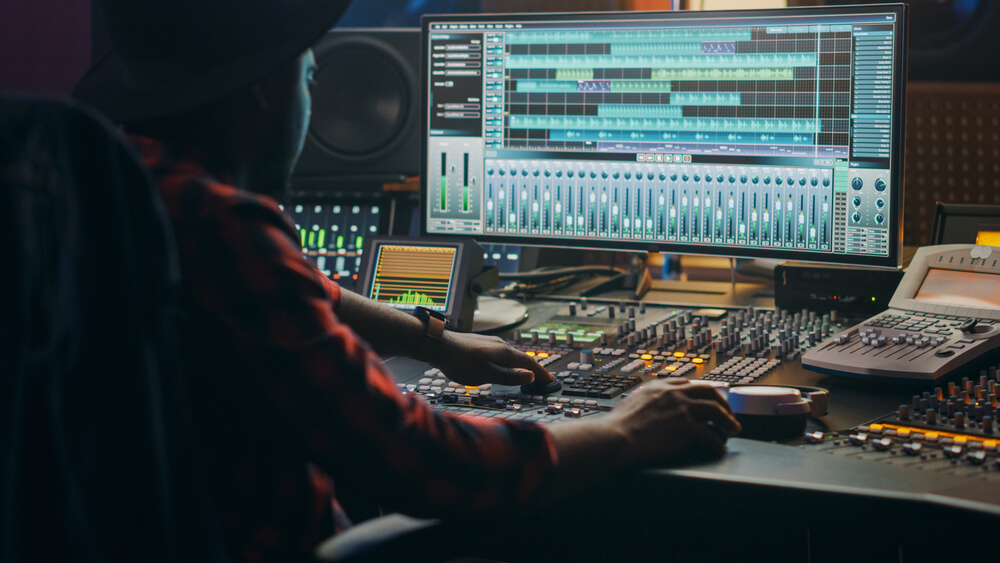When properly used, sound effects can add texture and depth to every scene you shoot — and you don’t have to rent a rain machine or burn down your neighbor’s barn to create them. Read on to find out how to make the most of the resources out there and the best way to fit edited sound effects into your personal projects.
What are sound effects?
In the context of video editing, a sound effect is any non-musical or non-vocal audio that’s produced and pre-recorded. This can include thunderclaps during a rainstorm, footsteps in an empty hallway, or the famous Wilhelm Scream when the villain finally gets whats coming to him. For your purposes as a video editor, sound effects help to make your scenes feel more realistic without the time and expense of additional footage.
Unless it’s your job to create sound effects, chances are you’ll be working with Foley sounds. A Foley sound is an imitation of an everyday sound that is captured for use in a project. That guy using coconut shells to create the clip-clop sound of horse hooves? He’s a Foley artist. If you want to create your own sounds from scratch, go for it! But for most people, it’ll likely be easier and more feasible to download pre-made sound clips from an audio library.
How can I use edited sound effects?
Inserting audio effects into your project can elevate the viewing experience for your audience in a whole bunch of ways:
- To add realism. High-quality sound design reflects the soundscape of real life and immerses you into the action on screen. After all, it would sound a little weird if our protagonist was walking along a busy street and there weren’t any sounds of cars going by. That’s why you want to use movie magic to fake the well-rounded sounds of the real world.
- To build on the story. You can use sound effects to expand the narrative, even when you don’t have the footage to match. If your script requires a giant car crash but you don’t have the budget to hire a stunt person and crash a few cars, you can create an off-camera fender bender by combining the sounds of brakes screeching and glass breaking with some well-timed reactions from your actors on screen.
- To provide emotional texture for your movie. A robust soundscape can draw viewers into the scene and make them more invested in the action. For example, you can use sound effects to reflect your protagonist’s state of mind. Think about the difference between a restaurant conversation accompanied by sounds of tinkling silverware and muted voices versus one set by the sound of a character’s quickly beating heart. Changing the ambient noise can change the entire tenor of a scene.
Where can I find edited sound effects?
Professional movie studios often pay royalties for the music and sound effects they use based on how many times a clip is played. But for those of us without a movie-studio budget, there are plenty of sites that provide royalty-free sound files for free — or at least for a monthly subscription fee. Here are a few to get you started:
- Artlist. Artlist is notable among creative asset libraries in that it offers an extensive collection of both sound effects and music. You can get it free for 30 days; beyond that, plans start at $9.99/month.
- Epidemic Sound. Best known as a source for royalty-free music, Epidemic Sound is also home to a solid collection of sound effects — about 90,000 in total. Like Artlist, the site offers a month-long trial, but paid plans have a slightly higher cost of $15/month.
- BBC Sound Effects. You can find upwards of 30,000 sound effects courtesy of "the Beeb” for exactly $0, though not for commercial use. If you do plan to make money off of them, there’s a licensing fee.
- Freesound. Freesound offers more than 400,000 sound effects, though whether they’re allowed in your project depends on how you plan to use them. Rules vary from file to file, so you may need to read some fine print if there’s money involved.
How to add edited sound effects in Descript
Once you’ve found the audio files you want to use, adding them to your Descript project is super easy:
- Import the file into Descript. You can import the file into your project with a simple drag and drop onto the project page or by clicking the “Add new” button on your sidebar.
- Place it where you want it. Again, you can do this by clicking and dragging the audio where you need it to go in the timeline. You can also just move it around in your project transcript.
- Edit the effect (if necessary). If your effect doesn’t quite sound the way you want it, right-click the sound clip in your timeline and select “Show clip properties.” From there, you can adjust the duration, volume, or clip speed, or click “Add effect” for fancier effects like reverb and distortion.
3 Tips for adding sound effects to your videos
Here are some tips to keep in mind as you’re fitting sound effects into your project:
- The fader is your friend. If your sound effect is more ambient — like a rainstorm — you can try introducing it gradually by fading it in and out. You can fade right from the timeline by clicking and dragging the triangle-shaped fader tool in the top corner of the clip.
- Use the transcript view. One of the benefits of Descript is the way it lets you view the project like you would a document. Thinking about your soundscape in the context of reading your story rather than fiddling with it on the timeline can give you a different perspective of when to bring in a certain sound — and you can drop the audio file right into the script at the moment you want it to come in.
- Don’t be afraid to mix it up. Your sound effects won’t be offended if you give them a bit of echo or cut them up to create a choppy effect. If you don’t like the result of your edited sounds, you can always undo your actions afterward.


































